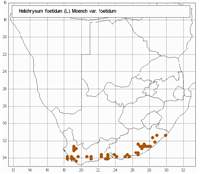Common names:
Geel sewejaartjie, Geel vlei-sewejaartjie, stinking strawflower (USA)
Origin of name:
foetidus /-a/-um = evil-smelling
Diagnostic characters:
Bi-coloured leaves (grey below)Large solitary heads in open branched inflorescenceBright yellow bracts
Description:
Stout biennial herb, foetid, stem simple or sparingly branched from the base, up to c. 1 m tall, glandular-pubescent, young parts thinly white-tomentose as well, leafy. Radical leaves more or less rosulate in first year of growth, withered at flowering, up to c. 120 x 50 mm, elliptic, apex obtuse to subacute, mucronate, base auriculate-clasping, upper surface sparsely pubescent, lower thinly white-tomentose; cauline leaves mostly 40�90 x 10�25 mm, smaller on the inflorescence branches, lanceolate, apex very acute to acuminate, base broad, cordate-clasping, upper surface rather harshly glandular-pubescent, lower thinly white-tomentose. Heads heterogamous, depressed-globose, c. 8�12 mm long, c. 15�25 mm across the radiating bracts, many in a large, leafy, spreading corymbose panicle. Involucral bracts in 8�9 series, graded, imbricate, inner much exceeding the flowers, tips acute, glossy, deep to pale lemon-yellow or creamy. Receptacle shortly honeycombed. Flowers 396�835, 54�262 female, 201�694 homogamous, female sometimes outnumbering homogamous. Achenes 0.75�1 mm long, glabrous. Pappus bristles many, equaling corolla, scabrid, bases cohering lightly by patent cilia.
Flowering between October and May.
Distribution:
Often a constituent of shrubby growth in valleys, on hill and mountain slopes, particularly in damp places along streams or on forest margins; can become a weed. Recorded from the environs of the Umtata River, Transkei, to the hills around Komgha, King William's Town and Stutterheim, the Amatola Mountains and Katberg, thence along the coastal mountain ranges to the Cape Peninsula and northwards through Worcester and Tulbagh to the Cederberg.
Fynbos, Thicket, Grassland and Savanna Biomes.
Notes:
H. foetidum is closely allied to H. cooperi, which gradually replaces it from the Amatola Mountains and Transkei northeastwards to the summer rainfall area. H. cooperi can be distinguished by its leaves, often decurrent on the stem and lacking white wool below.
Naturalized in W. Europe, Madeira and Hawaii. Records from tropical Africa are either introductions or misdeterminations: H. foetidum var. microcephalum A. Rich is a distinct species (probably H. glutinosum A. Braun fide Wild, pers. comm.). Also introduced to the USA.
Taxonomy:
Literature:
Helichrysum foetidum (L.) Moench, Meth. Pl. 575 (1794); Cass. in Dict. Sci. nat. 25: 469 (1822); Less., Syn. Comp. 284 (1832); DC., Prodr. 6: 187 (1838); Harv. in F.C. 3: 232 (1865); Moeser in Bot. Jb. 44: 336 (1910); Levyns in Adamson & Salter, Fl. Cape Penins. 783 (1950); Clapham in Tutin et al., Fl. Europ. 4: 130 (1976).
Type:
Type described from Africa, Gnaphalium no. 13 in herbarium Hort. Cliff. (BM).
Synonym(s):
Gnaphalium foetidum L., Sp. Pl. 851 (1753); Sims in Curtis's Bot. Mag. t. 1987 (1818). Anaxeton foetidum (L.) Gaertn., Fruct. 2: 406, t. 166 (1791); Lam., Illus. t. 692 fig. 1 (1823).
Gnaphalium argenteum Mill., Dict. Gard. edn 8 no. 14 (1768). Type: no specimen found in BM, but contemporary specimens from Chelsea Physic Garden are a pale headed form of H. foetidum.
Xeranthemum corymbosum Lam., Encycl. 3: 242 (1789). Type: Cape of Good Hope (P-LAM).
Helichrysum foetidum var. citreum Less., Syn. Comp. 285 (1832); DC., Prodr. 6: 187 (1838). Type: no specimen found.
H. foetidum var. pallidum Less., Syn. Comp. 285 (1832); DC., Prodr. 6: 187 (1838). Type: no specimen found.
Vouchers:
Acocks 21717 (PRE); Compton 10698 (NBG); Flanagan 600 (PRE; SAM); Hilliard & Burtt 10814 (E; K; NU); Pillans 8494 (BOL)

